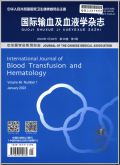基于SEER数据库的慢性髓细胞白血病患者预后分析
Prognosis analysis of patients with chronic myeloid leukemia based on SEER database
摘要目的:基于美国国立癌症研究所的监测、流行病学和结果(SEER)数据库中慢性髓细胞白血病(CML)患者的资料,探讨影响CML患者的生存预后因素及全因死亡差异。方法:选择SEER数据库收录中于2000-2017年诊断的18 505例CML患者为研究对象。将其按照诊断时间,分为2000-2005年组( n=5 255)、2006-2011年组( n=6 031)和2012-2017年组( n=7 219);按照患者的诊断年龄,分为15~44岁组( n=4 733)、45~64岁组( n=7 237)、65~74岁组( n=3 572)和75~84岁组( n=2 963)。采用SEER*Stat 8.3.9软件提取患者的诊断时间、性别、种族、年龄、生存结局、死亡原因、生存时间、调整后的家庭年中位收入、居住地等基本信息。患者性别、诊断年龄、人种构成比等计数资料的组间比较,采用 χ2检验。采用Kaplan-Meier法分别绘制不同年龄组及不同诊断时间组患者的总体生存(OS)曲线,各组总体比较采用log-rank检验,组间两两比较采用Bonferroni法对 P值进行校正。采用Cox比例风险回归模型对影响患者OS率的因素进行单因素及多因素分析。本研究遵循的程序符合2013年修订版《世界医学协会赫尔辛基宣言》要求。 结果:①本研究3组不同诊断时间组CML患者的一般资料比较结果显示,其诊断年龄、人种、调整后家庭中位年收入及居住地构成比分别比较,差异均有统计学意义( χ2=108.035、38.721、274.437、28.377, P<0.001、<0.001、<0.001、=0.002);仅性别构成比比较,差异无统计学差异( P>0.05)。②对本研究18 505例CML患者的中位随访时间为7.1年(3.3~11.7年),中位OS期为13.4年(未达到~3.8年),5年OS率为70.9%。随着CML患者诊断年龄的增加,其OS率降低,并且差异有统计学意义(4组总体比较: χ2=4765.639, P<0.001;任意2组比较, P<0.008)。随着患者诊断时间的推后,其OS率升高,并且差异亦有统计学意义(3组总体比较: χ2=273.461, P<0.001;任意2组比较: P<0.017)。③对可能影响本研究CML患者OS率的因素进行的单因素及多因素Cox比例风险回归模型分析结果显示,男性(女性患者比男性患者: HR=0.801,95% CI:0.761~0.842, P<0.001),年龄≥45岁(45~64、65~74、75~84岁组患者分别比15~44岁组: HR=1.756,95% CI:1.611~1.914, P<0.001; HR=4.349,95% CI:3.985~4.747, P<0.001; HR=9.147,95% CI:8.396~9.964, P<0.001),诊断时间在2005年之前(2006-2011年组、2012-2017年组患者分别比2000-2005年组患者: HR=0.730,95% CI:0.689~0.773, P<0.001; HR=0.579,95% CI:0.538~0.623, P<0.001),调整后家庭中位年收入<55 000 USD(调整后家庭中位年收入为55 000~74 999 USD、≥75 000 USD的患者分别比<55 000 USD者: HR=0.905,95% CI:0.852~0.962, P=0.001; HR=0.786,95% CI:0.733~0.843, P<0.001)及黑色人种(黑色人种患者比白色人种患者: HR=1.334,95% CI:1.236~1.439, P<0.001)是影响CML患者OS率的独立危险因素。④截至随访结束,本研究CML患者中,死亡患者为6 310例,全因死亡率为34.1%(6 310/18 505)。其中,1 921例(30.4%)因CML死亡,1 812例(28.7%)因并发其他肿瘤疾病死亡,2 486例(39.4%)因非肿瘤原因死亡,91例(1.4%)死亡原因不明。不同年龄组及不同时间组CML患者的死亡原因构成比分别比较,差异均有统计学意义( χ2=309.933、24.787, P<0.001、0.001)。 结论:在真实世界中,随着新型TKI参与CML治疗,CML患者预后逐渐改善,同时因CML死亡的患者占比逐渐降低。患者性别、诊断年龄、家庭收入,以及TKI可及性是CML患者生存预后的独立影响因素。
更多相关知识
abstractsObjective:To explore factors affecting prognosis of patients with chronic myeloid leukemia (CML) and differences in all-cause deaths based on case data of the surveillance, epidemiology, and end results (SEER) database.Methods:A total of 18 505 CML patients who were diagnosed from 2000 to 2017 and included in the SEER database were selected as research subjects. They were divided into 3 groups according to their diagnosis time: 2000-2005 group ( n=5 255), 2006-2011 group ( n=6 031) and 2012-2017 group ( n=7 219). Mereover, according to their diagnosis age, they were also divided into: 15-44 years old group ( n=4 733), 45-64 years old group ( n=7 237), 65-74 years old group ( n=3 572) and 75-84 years old group ( n=2 963). Patients′ basic data, such as diagnosis time, gender, race, age, survival outcome, cause of death, survival time, adjusted median annual household income and living region were extracted with SEER*Stat 8.3.9 software. Enumeration data such as composition ratios of gender, diagnosis age and race of patients among groups were compared with the Chi-square test. The Kaplan-Meier method was used to draw overall survival (OS) curves of patients among different age groups and different diagnosis year groups. The log-rank test was used for overall comparisons, and the Bonferroni method was used to adjust the P value for pairwise comparisons among groups. Univariate and multivariate analysis of factors influencing OS rate of patients were performed by Cox proportional hazards regression model. This study was in line with World Medical Association Declaration of Helsinki revised in 2013 and informed contents were obtained from the subjects. Results:① Comparing general data of patients among 3 different diagnosis years groups, there was no statistical difference in gender composition ratio ( P>0.005), but the differences in composition ratios of diagnosis age, race, adjusted median annual household income and living region were statistically significant ( χ2=108.035, 38.721, 274.437, 28.377; P<0.001, <0.001, <0.001, =0.002). ② The median follow-up time of 18 505 CML patients was 7.1 years (3.3-11.7 years), median OS time was 13.4 years (not reached-3.8 years), and 5-year OS rate was 70.9%. With the increase of diagnosis age of CML patients, the OS rate of patients decreased and the differences were statistically significant (overall comparison of 4 groups: χ2=4765.639, P<0.001; pairwise comparison between any two groups: P<0.008). As the diagnosis time went on, patients′ OS rate gradually increased and the differences were statistically significant ( overall comparison of 3 groups: χ2=273.461, P<0.001; pairwise comparison between any two groups: P<0.017). ③ The univariate and multivariate Cox proportional hazards regression model of factors that might influence OS rate of 18 505 CML patients in this study showed that male (female patients vs male patients: HR=0.801, 95% CI: 0.761-0.842, P<0.001), age ≥ 45 years old (45-64, 65-74, 75-84 years old groups vs 15-44 years old group: HR=1.756, 95% CI: 1.611-1.914, P<0.001; HR=4.349, 95% CI: 3.985-4.747, P<0.001; HR=9.147, 95% CI: 8.396-9.964, P<0.001), diagnosed before 2005 (2006-2011 and 2012-2017 diagnosis groups vs 2000-2005 diagnosis group: HR=0.730, 95% CI: 0.689-0.773, P<0.001; HR=0.579, 95% CI: 0.538-0.623, P<0.001), adjusted median annual household income <55 000 USD (patients whose adjusted median annual household income were 55 000-74 999 USD and ≥75 000 USD vs <55 000 USD: HR=0.905, 95% CI: 0.852-0.962, P=0.001; HR=0.786, 95% CI: 0.733-0.843, P<0.001) and black race (black race patients vs white race patients: HR=1.334, 95% CI: 1.236-1.439, P<0.001) were independent risk factors influencing OS rate of CML patients. ④ By the end of the follow-up, 6 310 patients had died among 18 505 CML patients in this study and the all-cause mortality rate was 34.1%(6 310/18 505). Among them, 1 921 cases (30.4%) died due to CML, 1 812 cases (28.7%) died due to other tumor diseases, 2 486 cases (39.4%) died due to non-tumor causes, and 91 cases (1.4%) died due to unknown causes. There were statistically significant differences in composition ratio of death causes of CML patients among different diagnosis age groups ( χ2=309.933, P<0.001) and different diagnosis time groups ( χ2=24.787, P<0.001). Conclusions:In real-world practice, as new tyrosine kinase inhibitor (TKI) continue to be approved for CML treatment, the prognosis of CML patients gradually improves and percentage of CML patients who died due to CML itself gradually decreased. Gender, diagnosis age, family income and TKI accessibility were independent factors influencing the prognosis of CML patients.
More相关知识
- 浏览0
- 被引0
- 下载0


相似文献
- 中文期刊
- 外文期刊
- 学位论文
- 会议论文



 换一批
换一批 换一批
换一批



